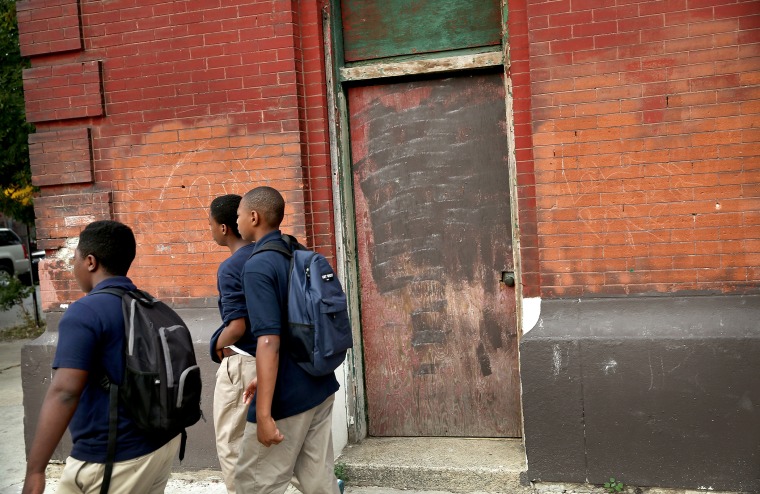The Obama administration has called on public school officials to rein in the use of “zero-tolerance” policies and law enforcement in giving out discipline to students, a practice that has ensnared minority and special needs students disproportionately.
“Too often, so-called zero-tolerance policies, however well-intentioned, make students feel unwelcome in their own schools. They disrupt the learning process and they can have significant and lasting negative effects on the long-term well-being of our young people – increasing their likelihood of future contact with juvenile and criminal justice systems,” Attorney General Eric Holder said on Monday, during an event at Frederick Douglass High School in Baltimore, where he and Secretary of Education Arne Duncan announced a slew of new guidelines for school discipline.
“We’ve seen that severe discipline policies often increase the numbers of suspensions and expulsions without effectively making schools safer or creating better learning environments,” Holder continued. “And we’ve seen that the impacts of exclusionary policies are not felt equally in every segment of the population – with students of color and those with disabilities often receiving different and more severe punishments than their peers.”
African-American and special-education students, particularly boys, are far more likely than their white peers to be suspended for minor or similar infractions, according to a number of recent studies, including one by the Education Department’s Office for Civil Rights, which found that black students without disabilities are suspended or expelled at a rate three times that of their white counterparts.
In one government study from 2011-2012, black students made up just 15% of the students in the data collection but represented more than a third of students suspended once. For students suspended more than once, their share jumped dramatically, to 44%.
Additionally, more than half of all students arrested at school were black or Hispanic.
On Wednesday, the Justice Department and the Department of Education released a 35-page document which outlines recommendations for school officials on best practices in implementing disciplinary policies and creating safer, more welcoming school environments. The recommendations include evidence-based prevention strategies, various teacher and administrator trainings, and greater collaboration between schools and local mental health and child welfare organizations. Other recommendations include more clearly defined responsibilities for school security officers and opportunities for school security personnel to forge relationships with students.
In recent years, criminal charges against students have risen, a troubling trend that has angered parents and civil rights organizations. Many of these arrests are for minor infractions that in the past could have warranted little more than a trip to the principal’s office.
Holder said the guidance will assist school districts and public elementary and secondary school teachers and administrators in meeting their obligations under federal law to develop and implement disciplinary policies without discrimination. And that it offers evidence-based alternatives to exclusionary discipline and fresh approaches for monitoring and addressing racial and other disparities.
“Even more critically,” Holder said, “it will offer new tools for educators, policymakers, and parents to promote fair and effective practices that make schools not only safer, but more supportive and inclusive.”
Critics of so-called “zero-tolerance” policies say that school officials have essentially pushed minority students from the corridors of schools to prison cells.
“These much-needed guidelines send a strong message from the federal government that it takes seriously the criminalization of children, particularly children of color, in schools,” said Sherrilyn Ifill, the president and director-counsel of the NAACP Legal Defense and Educational Fund. “It acknowledges that race plays an improper role in school discipline practices with long-term negative consequences for students’ educational outcomes.”
Janet R. Wettach, director of Duke Law School’s Children’s Law Clinic, said the administration’s recommendations “seem to be on the right track.”
"Referral to juvenile and criminal courts should very rarely be needed to resolve school issues,” Wettach said. She said that restorative justice and peer mediation programs, along with adequate training for school personnel in discipline and crisis management, would go a long way to avoiding serious discipline problems in schools.
Randi Weingarten, president of the American Federation of Teachers, said zero-tolerance policies “shine a light on a problem but solve it with sanctions instead of supports.”
While applauding the administration’s bold steps in addressing the costly disparities created by the flawed and widely implemented school disciplinary policies, Weingarten said the efforts will be moot if schools aren’t also provided resources to implement the new recommendations.
“The federal government made many positive suggestions, but policies in a vacuum without actual resources and support will not succeed,” Weingarten said in a statement shortly after Wednesday’s event.
The AFT released its own set of recommendations for school discipline.
The administration’s recommendations were also received cautiously by some experts, who say changing entrenched school cultures could be challenging.
“We often talk about solving this problem as if it’s an easy problem to solve,” James Forman Jr., a clinical professor at Yale Law School, told the New York Times. “Actually creating a positive school climate, particularly in schools that are in communities that are themselves not calm and orderly, is hard work.”
